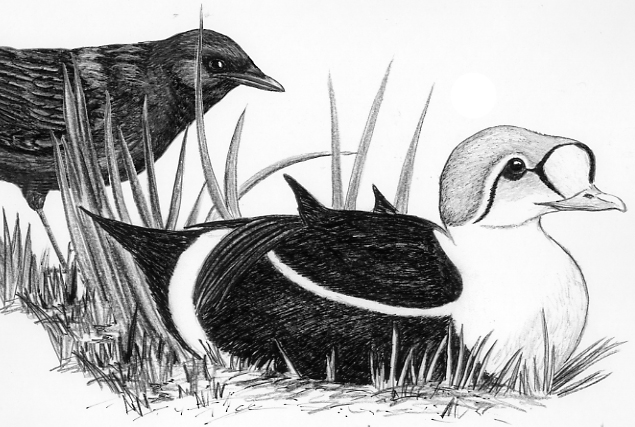
Dear Bird Folks,
Yesterday morning a friend of mine dragged me out of bed at the crack of dawn and drove me to Scusset Beach to see a King Eider. We hung around in the cold for two hours before we finally left without ever seeing the bird. My friend wants to try again next week, but I’m not sure if seeing this bird is worth all the effort. What do you think?
– Mark, Middleboro, MA
Of course it’s worth it, Mark,
Get out of Middleboro and go look for the bird. What are you going to do all day, hang around in the house and watch Regis and Kelly Lee? However, I ‘m surprised your friend knows where Scusset Beach is. He may be the only one.
For anyone who doesn’t know, and I’m betting that’s most everyone, Scusset Beach is in Sandwich (MA). But it’s on the other side of the Cape Cod Canal, in a part of Sandwich that even the people in Sandwich don’t know about. To get there from the Cape, take the first exit after crossing the Sagamore Bridge. Drive past the McDonalds that nobody ever stops at (except to use the bathroom), and you’ll find Scusset Beach State Reservation at the very end of the road. It’s a beautiful location, with a wide beach along Cape Cod Bay, plus a trail that runs along the Canal. Anyone who visits this time of year really needs to dress warmly because Scusset Beach averages 130 degrees colder than the rest of the state. So if it’s 40 degrees when you leave home, it will be 90 degrees below zero at the beach.
I could have seen you there, Mark, because I too went looking for that King Eider. However, I wasn’t there at the “crack of dawn.” It was more like the crack of noon. I went later in the day because I’m lazy and because the light is better. It’s a whole lot easier to identify birds when the sun is at your back than when it’s blasting you in the face. Unfortunately, on this day the sun trick didn’t help me. I saw lots of good birds, including Harlequin Ducks, but like you I didn’t see the King Eider. Perhaps I missed the bird because I was busy watching where I stepped. This beach was crawling with people and their dogs, which were happily running in between the “pets prohibited” signs. Apparently, Scusset Beach is in the illiterate part of Sandwich.
It’s too bad we both missed seeing the King Eider because they certainly are handsome birds. King Eiders are slightly smaller than Common Eiders only with a more striking appearance. With their jet-black bodies, white breasts, orange faces and powder blue heads (really, powder blue) the male King Eider looks like an escapee from Cirque du Soleil. Seeing one around here in February is a treat because, believe it or not, wintry New England is too warm for them (again, really). These birds spend their winter days among the ice flows of the Labrador Sea and the Gulf of St. Lawrence, where they dive for mussels and assorted crustaceans.
Don’t give up on trying to see a King Eider, Mark. They are worth the effort, plus looking for one will get you out of Middleboro. Regrettably, I’m going to cut my response to your question a little short because there is another topic that I had better respond to before my answering machine explodes.
It recently has come to light that the National Park Service is thinking about poisoning some American Crows in an effort to protect struggling Piper Plovers. Many people are upset by this idea. I’d like to point out that the worldwide population of Piping Plovers is a measly few thousand birds while the American Crow population is in the neighborhood of thirty-one million. Crows have prospered as the result of our sloppiness, thriving on our cornfields, dropped French fries and road kill. The plovers have not been so fortunate. Our bulging population has pushed them toward the brink. Without human intervention, these little birds will most likely go the way of the Passenger Pigeon.
Assigned the job of protecting the plovers on the Outer Cape are the hardworking folks at the Cape Cod National Seashore. These dedicated naturalists are passionate about all wildlife and take their stewardship of all that has been entrusted to them very seriously. This is why it pains me to ask: What the heck are they thinking? Poisoning crows? Are you kidding? Everyday I fight with boneheads who want to kill squirrels, chipmunks, Blue Jays, cormorants or anything else that annoys them. Some people believe they have the right to shoot whatever is keeping the cardinals away from their feeder or messing up their boat. I tell them that killing is a moron’s way of problem-solving (Then I usually have to duck).
Any egregious action can be justified if we try hard enough. It’s up to the adults in charge to show us a better way. In this case, the adults are letting us down. Yes, plovers need protection, and while poisoning other birds on their behalf might be an easy solution, it isn’t the right solution. There’s a better answer out there. It would be nice if the proper effort were made to find that answer. That’s all I’m saying.
If anyone is looking for me, I’ll be at the local IRS office, having my taxes audited.